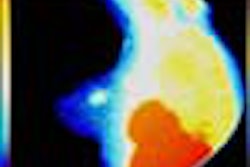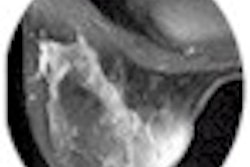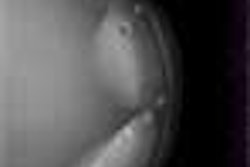A genetic test that determines whether breast cancer is hereditary may someday help radiologists determine who should receive more frequent and highly sensitive follow-up imaging procedures.
The test differentiates between breast cancers caused by an inherited mutation in the BRCA1 or BRCA2 gene and cancers that are non-inherited, according to a study published in the New England Journal of Medicine. It’s based on a technique called gene expression profiling, which catalogs genetic activity by detecting whether genes are making, or expressing, proteins.
In the study, researchers from the National Human Genome Research Institute used a fluorescent dye to label the DNA extracted from BRCA1, BRCA2, and non-genetic cancer tumors. They found that each type of cancer is characterized by a unique group of genes -- a fingerprint that can be identified by genetic profiling (NEJM, February 22, 2001, Vol.33:8, pp.539-548).
"This could help determine how patients are followed after they’re diagnosed," said Dr. R. James Brenner, director of breast imaging at Tower/Eisenberg-Keefer Breast Center in Santa Monica, CA. "If certain genetically based tumors pan out to be more aggressive, these patients might be imaged more frequently and with modalities generally reserved for high-risk patients, such as MRI."
Used this way, the test could give physicians a jump on the 9,000 cases of hereditary breast cancer diagnosed each year in the U.S. It could also ensure that high-risk women are more closely monitored, as recommended in 1997 by a National Human Genome Research Institute task force.
According to that report, women with the BRCA1 mutation should receive early breast and ovarian cancer screening, and women with the BRCA2 mutation should receive early breast screening (Journal of the American Medical Association, March 26, 1997, Vol.277:12, pp. 997-1003).
Even so, some radiologists downplay the impact of gene profiling on the day-to-day job of reading mammograms.
"From my point of view, whether a patient is a gene carrier or not doesn’t impact how I interpret images, aside from increasing the call-back rate in patients we know are high-risk," said Dr. Dulcy Wolverton, an associate professor of clinical radiology with the breast imaging section at the University of California, San Francisco.
And according to one study, mammography is no more sensitive in detecting breast cancer in women with a family history of the disease than those without. The multicenter study, published in Annals of Internal Medicine, analyzed data from 389,000 women in seven mammography registries, and found that mammography missed a similar percentage of cancers in both populations. Age, not family history, influences the sensitivity of mammography, the researchers concluded (Annals of Internal Medicine, Dec. 5, 2000, Vol.133:11, pp.855-863).
These findings are compelling, but they can’t dampen the increased anxiety of reading a high-risk patient’s mammogram. The lifetime risk of developing breast cancer is between 80% and 90% for carriers of the BRCA1 mutation, and between 60% and 80% for those with the BRCA2 mutation.
Wolverton added that if a known carrier of either gene received a mammogram with borderline abnormalities, odds are the patient would be referred for a biopsy. Dr. Rebecca Smith-Bindman, assistant professor of radiology, epidemiology, and biostatistics at UCSF, said ambiguous mammograms would be treated with more suspicion if the patient is genetically predisposed to cancer.
Such increased suspicion is justified, according to a Dutch study published in the Journal of Clinical Oncology. Researchers performed mammograms on 1,198 women, which included 449 women with a moderate risk of cancer, 621 high-risk women, and 128 carriers of either the BRCA1 or BRCA2 mutations. Women with the gene mutation exhibited a higher incidence of cancer -- 33 cases per 1,000 person-years, compared to three and eight cases for the moderate and high-risk groups, respectively (Journal of Clinical Oncology, Feb. 15, 2001, Vol.19:4, pp.924-930).
"The test could make our jobs easier," Smith-Bindman added. "It could increase the likelihood of true-positive findings rather than false-positive findings, which is important because mammography has a low positive predictive value."
Gene expression profiling could also usurp gene sequencing, the current method for determining whether breast cancer is inherited, Brenner said. The technique is expensive and time-consuming, in part because only one company in the nation, Salt Lake City-based Myriad Genetics, is licensed to conduct genetic screening for breast and ovarian cancer, he said.
Consider a case in which a young woman develops breast cancer, Brenner said. It's unusual -- maybe it’s just bad luck, or maybe it’s a germ-line problem, meaning her cancer has a genetic origin. Instead of genetic testing her entire family to rule out heredity, which is an expensive and slow process, this new test could be used, he said.
By Dan KrotzAuntMinnie.com contributing writer
March 22, 2001
Related Reading
Radiotherapy safe and effective for breast cancer patients with BRCA mutations, September 30, 2000
Click here to post your comments about this story. Please include the headline of the article in your message.
Copyright © 2001 AuntMinnie.com



















